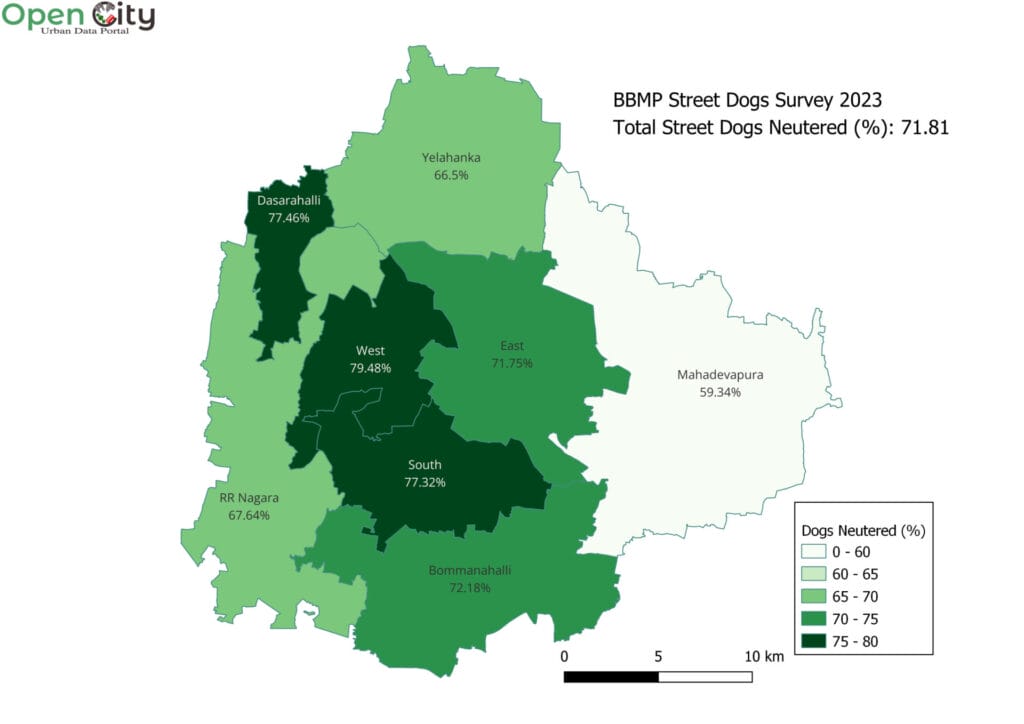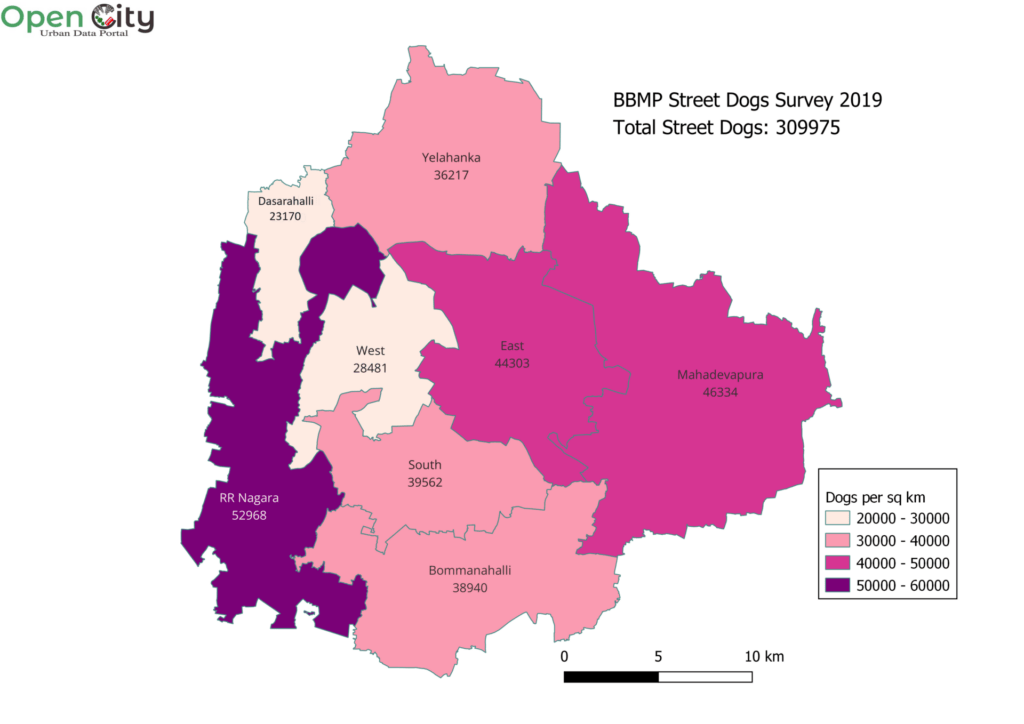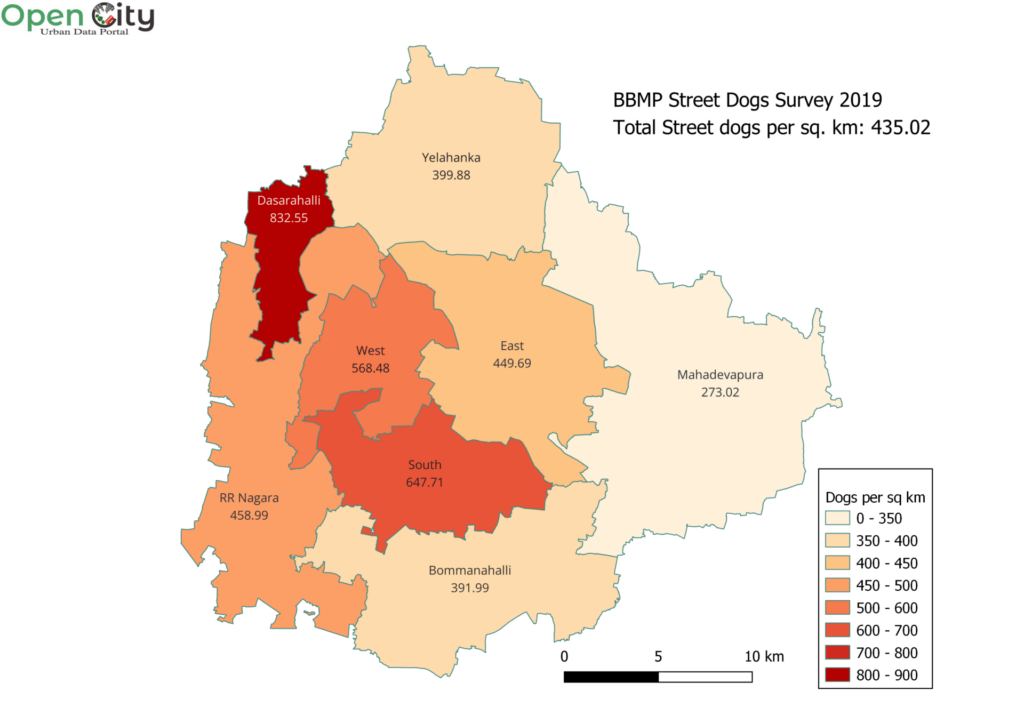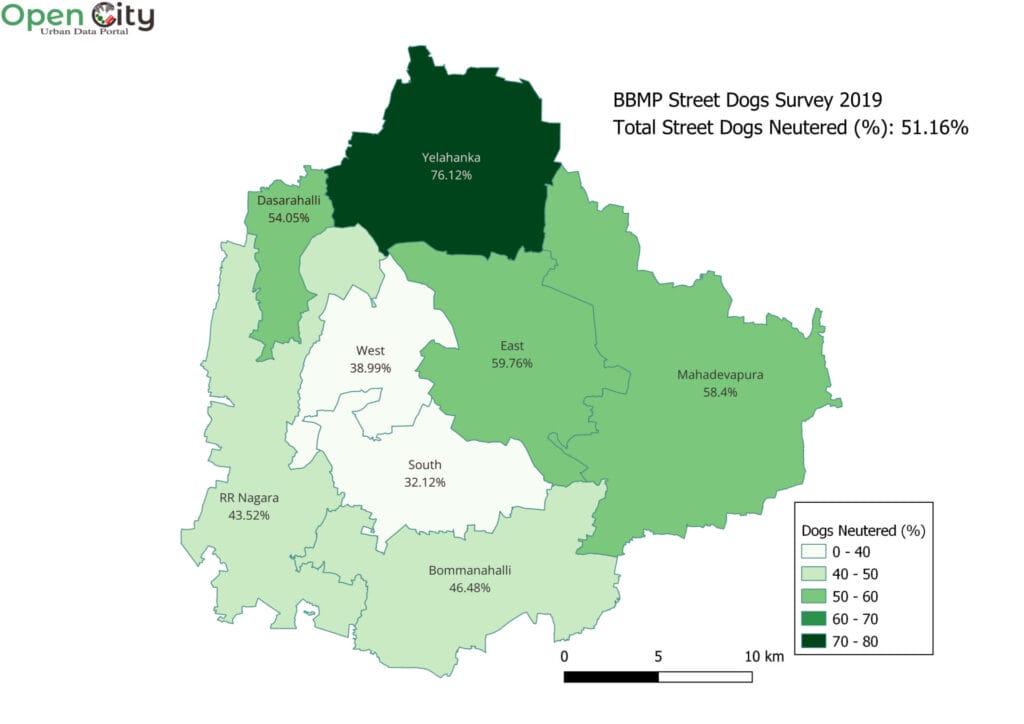BBMP recently released the data from the street dog survey conducted over July and August 2023. The survey estimates that there are 2.79 Lakh (2,79,335 to be precise) dogs on the streets in BBMP’s area. This is down from the estimated 3.10 Lakh (3,09,975 to be precise) dogs in 2019, a decline of 9.88% over the four year period.
Variation within the city
The survey report shows that the 2.79 lakh dogs are not evenly distributed across the city.

Src: BBMP street dogs survey 2023. Graphic: OpenCity.in
While Mahadevapura zone hosts 21% of the total street dog population, Dasarahalli has 7.6% of the population of street dogs. This is also commensurate with their areas, as Mahadevapura and Dasarahalli are the largest and smallest zones respectively. A better measure would be the density of street dogs or the number of street dogs per sq. km.

Src: BBMP street dogs survey 2023. Graphic: OpenCity.in
The density of street dogs paints a different picture. While the average number of street dogs per sq.km in BBMP’s area is 392, Dasarahalli has close to double the average at 762 dogs per sq. km, while Mahadevapura has less than the average at 344 dogs per sq.km.
Among the rest of the zones, Bangalore South zone seems to be doing the best with both less number of dogs and lower than average density.
One of the most important measures employed to reduce the population of street dogs is animal birth control or neutering of dogs. While on average 71.81% of the dogs in BBMP’s area were found to be neutered, there is a large variance between the zones.

Src: BBMP street dogs survey 2023. Graphic: OpenCity.in
Despite having a high density of dogs, 77.46% of dogs in Dasarahalli are neutered. Mahadevapura comes last with less than 60% of the dogs neutered. These different rates of neutering give us an indication of the change in numbers over the last four years.
Comparing with the situation in 2019
Before we delve into the changes in the last four years, it needs to be mentioned that there has been a change in methodology in the survey. According to Priya Chetty-Rajagopal, a Bengaluru-based Executive Search Consultant, and a citizen activist, “this year, both the animal husbandry teams and volunteers were assigned the task using global census methodologies. In addition, using technology, like gathering data on software, using GPS apps and data, and drones to assess the population of community dogs, have contributed to the robustness and reliability of the data collected. Obviously, no data can be 100% accurate, considering that many dogs cannot be easily found (which is missing data) or some dogs may cross territorial boundaries that could result in duplication of numbers.”
With that caveat, what we saw four years back, while there were 10% more dogs estimated, was that the zonal variation was very different.

Src: BBMP street dogs survey 2019. Graphic: OpenCity.in
Rajarajeshwari Nagar zone boasted the most number of dogs – 17% of the dogs in BBMP’s area. The much larger Mahadevapura zone had 15% of the dogs, almost the same as the neighbouring East, much lower than what we see now.
In terms of density, again Dasarahalli had the highest, but much higher than the current numbers. What is interesting is that South Zone which showed such low numbers in 2023 ranked second highest in terms of density with close to 650 dogs per sq. km, compared to the current 380.

Src: BBMP street dogs survey 2019. Graphic: OpenCity.in
The difference we see in the four years can be put down to the rate of neutering of dogs. While only 51.16% of the dogs in BBMP area were estimated to be neutered as per the 2019 survey report, the percentage has increased to 71.81% in 2023.

Src: BBMP street dogs survey 2019. Graphic: OpenCity.in
While most of the zones in Bengaluru have significantly increased their rates of neutering in the last four years, Mahadevapura’s rate has remained more or less constant at just under 60%. Yelahanka also seems to have dropped the ball in the same period.
The increase in animal birth control measures in most areas seems to have paid significant dividends for the zones.

Src: BBMP street dog surveys 2019 and 2023. Graphic: OpenCity.in
While South zone has reaped significant rewards reducing their street dog population by a massive 41%, Mahadevapura zone has seen a significant increase of close to 26%. Yelahanka and Bommanahalli have shown marginal increases which need to be controlled with stronger measures.
While animal birth control measures can achieve better control of population it does not seem to be the only factor. While RR Nagar and Yelahanka have almost identical rates of neutering, the population of dogs plummeted by 22% in RR Nagar but increased slightly in Yelahanka. Despite 72% of the dogs being neutered in Bommanahalli there was a marginal increase seen there also.
Read more: BBMP’s street dog census: What the findings imply for citizens
The correlation seems to be more direct in the inner zones – East, West and South – where an increase in neutering seems to have yielded significant decrease in street dog population in the last four years.
Measures for an effective implementation of the ABC programme in a ward
According to citizen activist, Priya Chetty Rajagopal, the following are required:
- Following ABC Rules 2023
- Prompt and good payment to contractors
- Ward health inspector to work closely with BBMP AHVS to ensure coverage
- Encouragement to ward citizens to bring friendly-dogs to ABC centres
- Hands on and committed municipal admin, for example the BBMP
- Strong process and statements of purpose (SOPs)
- Competent catchers and surgeons
- Excellent pre and facility surgery and safe release of the dogs
- Zonal division mapped to the BBMP Assistant Director’s
- Strong participation and overseeing with animal lover communities, example relevant squads and groups
- Accurate and well-documented metrics and data
- Awareness campaigns to educate localities and groups, especially children
- One or two full-time vets assigned per zone

The role of human population
Street dogs depend on human populations for their subsistence, be it through direct feeding or waste generated. Growth in human populations tends to be accompanied by growth in street dogs in most areas.
Over the past decades the population of Bengaluru has grown rapidly. While the last census estimated 8.4 million to be living within BBMP’s area the current estimates vary from 12-15 million. In the absence of a census the closest estimate we have is the voter rolls, which show the growth of the city in the last five years.

Src: ECI Voter rolls data. Graphic: OpenCity.in
Voter data shows that while the population inside the core areas of the city has remained more or less constant, it has been booming in the outer areas, even beyond BBMP boundaries. More and more people are moving into and living outside BBMP boundaries, especially in the Eastern and Southern parts of Bengaluru. The ward-level street dog population map in the survey report of 2023 also shows a much higher presence of dogs in peripheral wards.

As much as neutering and vaccination percentages need to be increased as much as possible, garbage collection is an important issue that needs to be addressed. Even assuming that BBMP gets its collection right within its boundaries and eliminates black spots, the collection in areas outside BBMP, in the surrounding panchayats, is usually not up to the mark and black spots are common in many of these areas.
Increasing street dog populations in the surrounding panchayats will show up as higher numbers in the peripheral wards – any reduction in numbers due to animal birth control will be offset by booming numbers just outside the ward boundaries. Any long-term plan to control the population of street dogs has to involve the panchayats around BBMP as key stakeholders in both animal birth control and solid waste management. This also means that any survey of number of dogs should also include the surrounding panchayats to get a clearer idea of population trends.
[This article has been republished with permission from OpenCity.in with minimal edits. The section ‘Measures for an effective implementation of the ABC Programme in a ward’ is by Priya Chetty Rajagopal]